Ventilation heat exchangers in livestock barns
Learn how ventilation heat exchangers work and the potential cost savings.
ISSN 1198-712X, Published August 2023
Introduction
Heating a livestock barn is expensive. Ventilation exhaust represents the largest heat loss from poultry barns during colder seasons; up to 85% of heat is lost in ventilation exhaust, and only 15% is lost through the building envelope (Figure 1).

Reducing ventilation rates will save energy, but the air quality inside the barn could suffer. Also, humidity levels would rise and levels of carbon dioxide and ammonia contaminants would increase. This is not a healthy environment for animals or for people.
Instead, use a ventilation heat exchanger to recapture a portion of the heat from the barn exhaust air and use this heat to pre-warm the incoming fresh air entering the barn. An increasing number of farms in Ontario use ventilation heat exchangers to reduce fuel bills while maintaining ventilation levels. Any barn requiring heat in the winter can benefit from a heat exchanger.
This factsheet explains how ventilation heat exchangers work and estimates fuel and potential cost savings. For example, a high-efficiency heat exchanger exhausting 1,000 litres per second (L/s) (~2,100 cubic feet per minute (CFM)) of air can save more than 120 L of propane or 80 m3 of natural gas every day, when the outdoor temperature is -20°C.
Barn ventilation basics
During warmer seasons, exhaust fans remove excess heat produced by the animals and heat gained through the barn walls and roof. Fresh air is drawn into the barn to replace the exhausted air. This keeps the barn temperature at a comfortable level for the animals.
During colder seasons, heat produced by the animals is often not enough to balance the heat lost from exhaust or from the walls and roof. Some ventilation is still needed to remove moisture, carbon dioxide and ammonia, and keep the barn environment healthy for animals and people. However, the replacement fresh air can be quite cold and can cool the barn down significantly. A heating system (often a propane or natural gas-fired heater) is used to maintain the barn temperature. By pre-warming the cold incoming air with a ventilation heat exchanger, much less supplemental heat is needed.
How a heat exchanger works
A heat exchanger transfers heat from one source to another. A cool fluid and a warm fluid flow in opposite or cross directions. Heat from the warm fluid dissipates into the cool fluid by conduction through the heat exchange surface. Car radiators, plate coolers, air conditioners and refrigerators all contain heat exchangers.
Inside a vehicle's radiator, hot engine coolant is cooled to keep the engine from overheating. In a dairy plate cooler, warm fresh milk is cooled to prevent it from spoiling. In a ventilation heat exchanger, warm exhaust air crosses paths with cool incoming air and sheds some of its heat, warming the incoming air, known as make-up air (Figure 2).
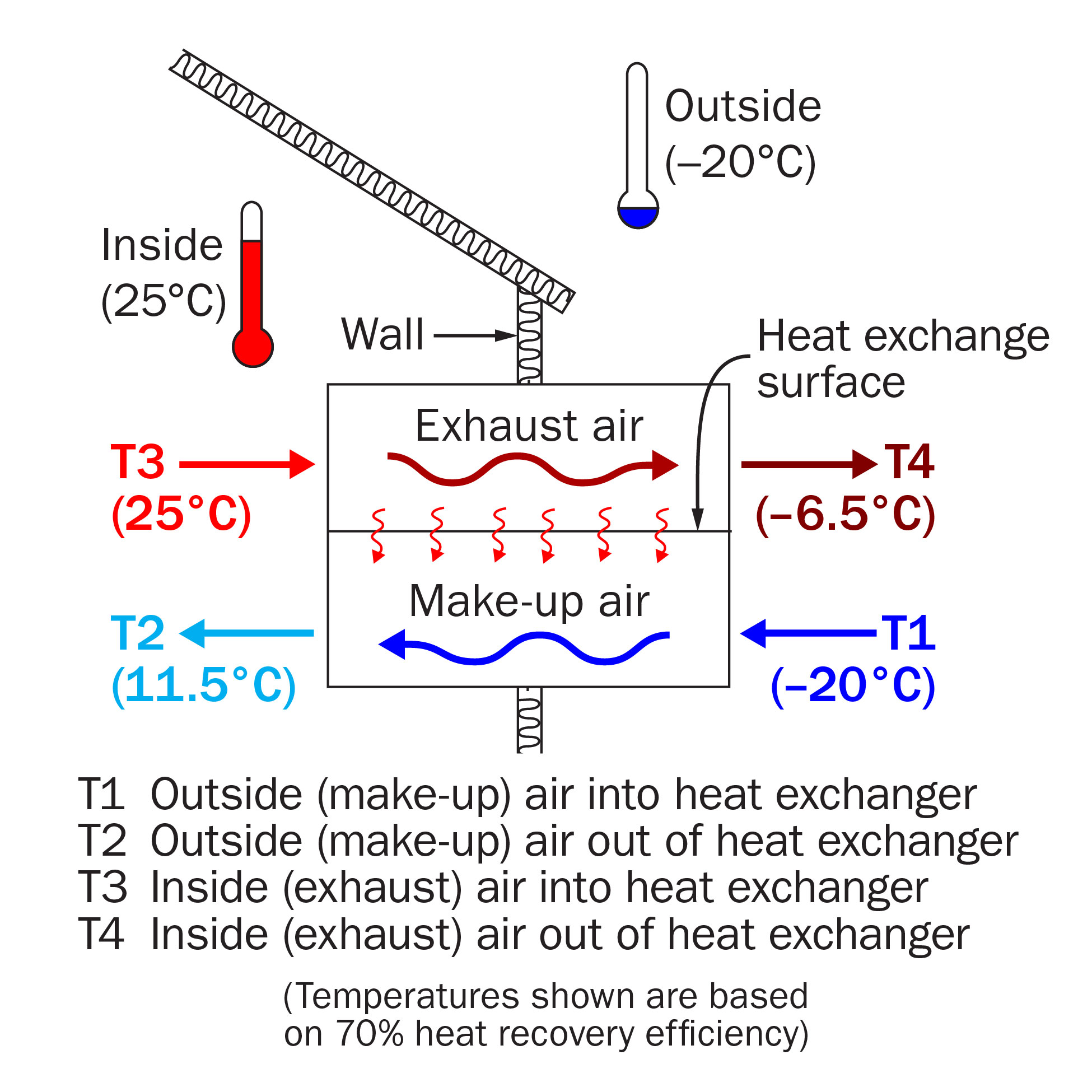
Inside a ventilation heat exchanger is the heat exchange surface (or core), a series of plates or tubes usually made from plastic or stainless steel. Barn exhaust air is very dirty (dust, dander, feathers), so the core keeps the exhaust and make-up air separate to prevent cross contamination. These contaminants build up on the core, reducing its heat transfer efficiency. Air filters can remove some material from exhaust air before it fouls the core. In some systems, an automatic washing system regularly flushes material from the core.
Heat exchangers are available in many sizes and configurations. A large stand-alone heat exchanger installed at a poultry barn is shown in Figure 3.
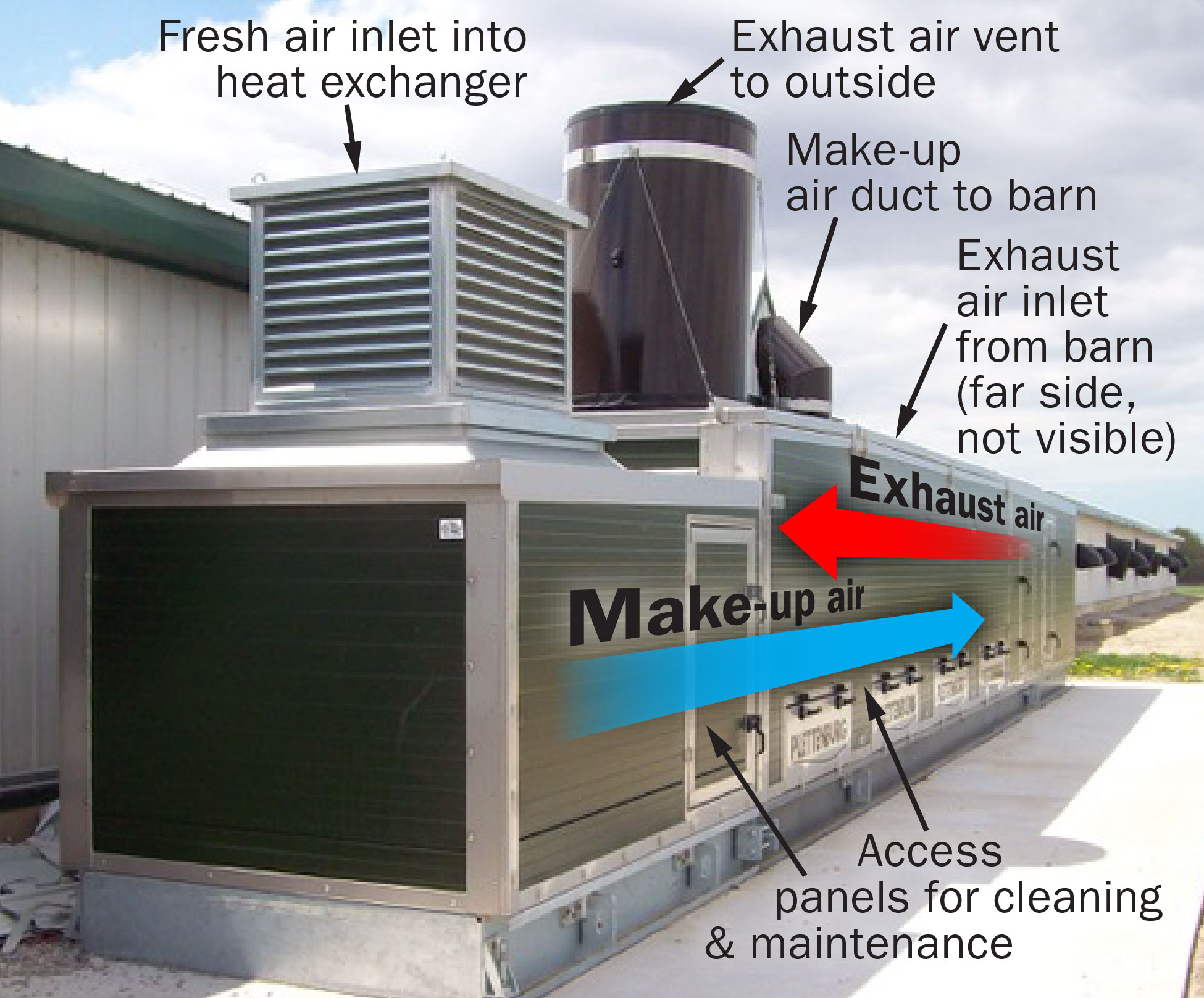
Heat exchanger terminology
To size and select a suitable heat exchanger, it is helpful to understand the various technical design terms used by the industry:
Heat recovery efficiency
This is the most important performance factor. It measures how well a heat exchanger recovers heat from the exhaust air, as a percentage. Most heat exchangers have efficiencies between 50%-80%. A heat exchanger with 50% efficiency recovers half of the available heat from the exhaust air.
Airflow range for multi-speed units
Most heat exchangers can adjust the airflow rate between a low setting and a high setting. Larger units may use variable frequency drives (VFDs) to allow variable air speeds. Select the airflow range to match ventilation requirements as animals grow during the production cycle.
Air moving efficiency
This performance factor measures the amount of power the heat exchanger uses to move a certain amount of airflow. This is normally measured in units of cubic metres per hour of airflow, per watt of power consumed (m3/h/W), or cubic feet per minute of airflow per watt of power (CFM/W). A higher number is more efficient.
Energy, money and greenhouse gas savings
Heat exchangers save energy because the make-up air is pre-warmed before it enters the barn, reducing fuel use. In Figure 2, the make-up air is 11.5°C after the heat exchanger, instead of -20°C if straight outside air were used. Since the barn temperature is 25°C, the make-up air only needs to be heated an extra 13.5°C, rather than being heated 45°C without a heat exchanger. The heating system uses much less fuel as a result, which saves money.
Reducing fuel use also reduces greenhouse gas emissions. A greenhouse gas (GHG) is any gas that traps heat in the atmosphere. GHGs are measured in kilograms or tonnes of carbon dioxide equivalent (CO2e), which means the amount of carbon dioxide released into the atmosphere. Burning fuel produces carbon dioxide (CO2) emissions. Different fuels release different amounts of CO2 when they are burned, so emissions can change if the fuel is changed.
The chart in Figure 4 estimates daily fuel savings and CO2 emission reductions when using a heat exchanger in a livestock barn. 3 efficiency levels are shown. The left side shows natural gas savings and corresponding CO2 reductions. The right side shows propane savings and corresponding CO2 reductions. The chart is based on a heat exchanger with airflow of 1,000 L/s (2,100 CFM) and a barn temperature of 25°C.
To estimate savings for a different airflow, multiply the fuel or GHG savings from Figure 4 by the new airflow (in L/s) and divide by 1,000. To find daily cost savings, estimate fuel savings from Figure 4, and multiply by the current price of fuel ($/m3 for natural gas and $/L for propane).
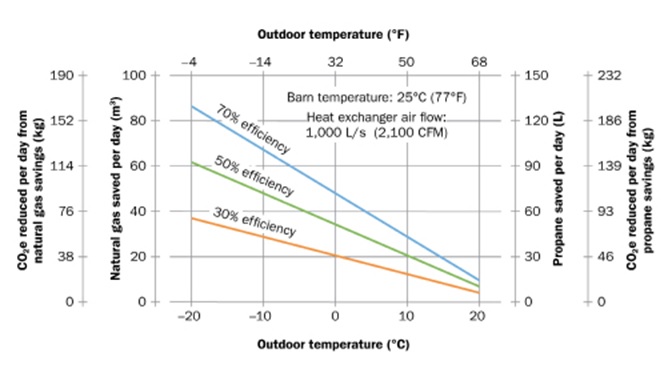
Installing a heat exchanger
Follow these guidelines to size and install a heat exchanger to be as effective as possible. Consult the heat exchanger manufacturer for specific details and available options.
Size heat exchangers to meet Stage 1 and/or Stage 2 minimum ventilation rates. For all-in, all-out barns, this varies as the animals grow. Purchase a unit with multi-speed control or a VFD. Size the heat exchanger for full-grown animals and operate at lower speeds (reduced airflow) for younger animals.
Install washable or cleanable exchanger surfaces and filters. Ensure the heat exchange surface (core) and filters are easy to access and clean. The core should be removable, or have easy-to-open access ports providing good access for inspection and/or cleaning. Purchase air cleaning equipment (filters, automatic wash systems) for the heat exchanger if available (Figure 5).
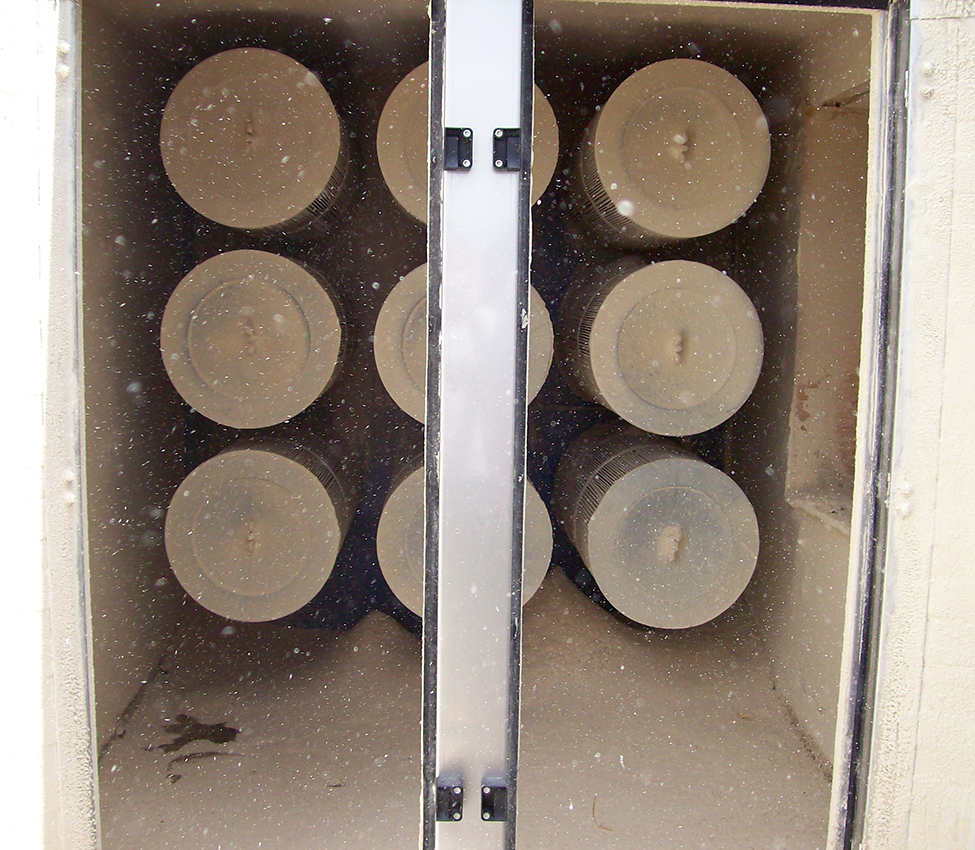
Install drain lines. Heat exchangers often remove enough heat that the exhaust air reaches its dew point (the temperature when condensation occurs), and water droplets form on the core. This water collects inside the unit and must be drained to an appropriate location. In addition, if an automatic wash system is used for cleaning, a drainage system is needed for the dirty wash-water.
Use defrost modes. In very cold weather, the core can fall below freezing, causing condensation in the exhaust air to freeze. Frost builds up quickly on the core and closes off the airflow, reducing the heat transfer significantly. Many heat exchangers have an automatic defrost setting that starts when outside temperatures are below a pre-set level (-5°C or less). Some units slow the fans to reduce airflow, or use a pre-heater on the incoming air stream to prevent freeze-up. For units without a defrost option, inspect the core several times per day in freezing weather. If frost is spotted, shut down the make-up air fan temporarily (if possible), and keep the exhaust fan running. This will warm up the core and melt the frost. Consider installing a pre-heater on the fresh air inlet if problems continue.
Distribute air effectively. To recover the most heat, a heat exchanger needs all the exhaust and intake fresh air to pass through the system. If one large heat exchanger is used, install ducting or circulation fans to distribute fresh air evenly throughout the barn (Figure 6). Most manufacturers can perform a smoke test to verify air distribution patterns inside the barn.
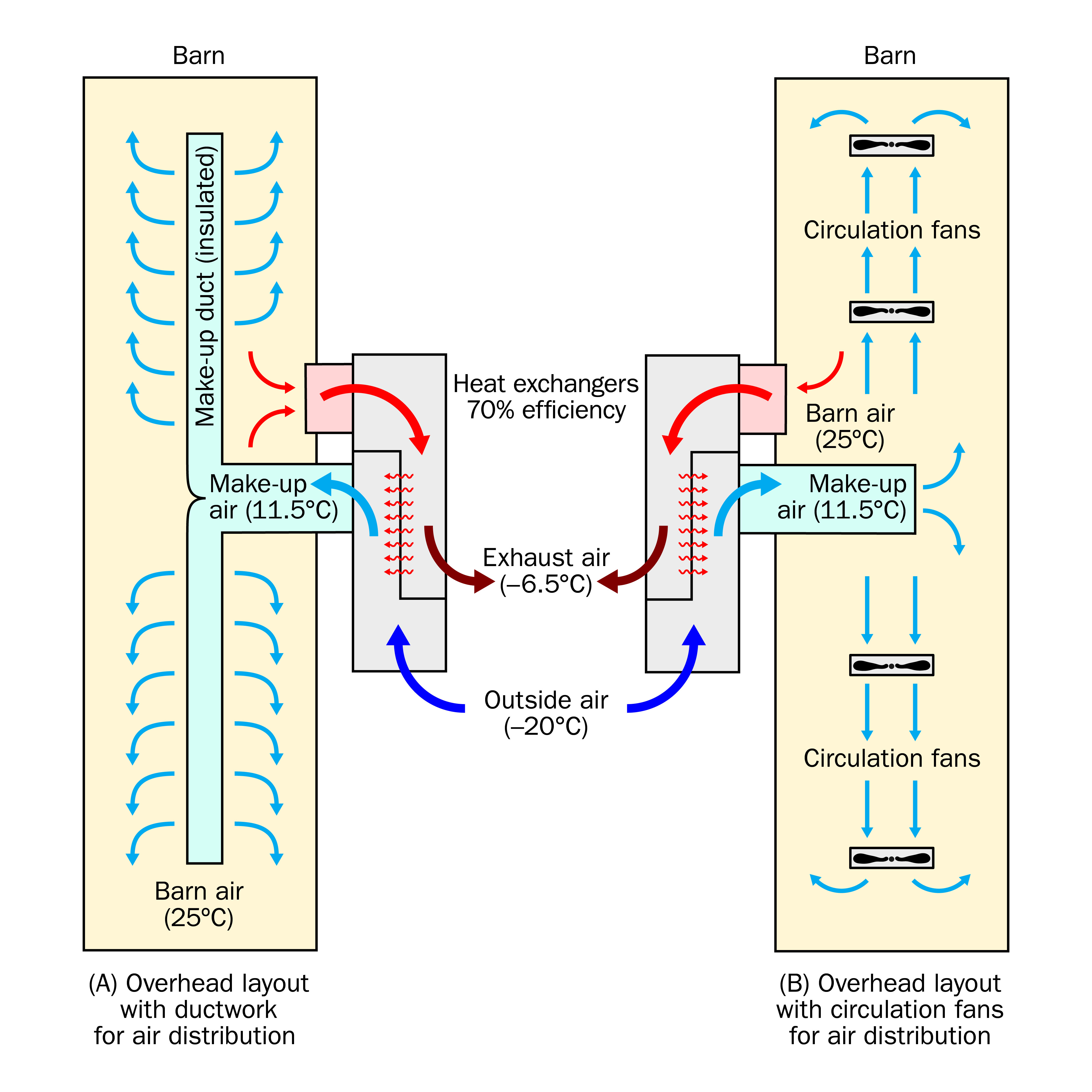
Insulate ducts. The fresh air ducts (if used) must be insulated. The duct surface will be cooler than the barn air. Without insulation, condensation could occur, creating a wet duct that must be cleaned to avoid the growth of pathogens.
Minimize duct/core leakage. Ensure the heat exchanger has good seals to prevent the exhaust and make-up air streams from mixing. Many manufacturers will state how much leakage occurs (percent of total airflow) on the performance data. Leakage will cause the fresh air side to become dirty, and pathogens can build up and create health issues in the barn.
Properly control exchanger and integrate with the ventilation system. A well-controlled heat exchanger reduces supplemental heat and replaces most or all ventilation in colder seasons. Follow these general control guidelines to maximize the heat recovery benefit:
- Set the heat exchanger to provide the desired airflow for moisture control during Stage 1 ventilation (minimum setting). If the barn temperature falls below the heating set-point, the heating system will activate.
- Most heat exchangers are multi-speed (variable speed or VFD). Operate the exchanger on a lower speed while the animals are young. Increase the fan speed to match the ventilation requirements as the animals grow. Program the barn ventilation controller to adjust fan speed automatically, or adjust manually if necessary.
- As the barn warms above the heating set-point temperature, the heating system will shut off. Continue operating the heat exchanger at the required speed to maintain moisture control.
- If the barn continues to warm up after the heating system is turned off, turn off the heat exchanger. Run the regular wall-mounted ventilation exhaust fans to keep the barn cool.
Maintaining a heat exchanger
An ignored heat exchanger is no better than a regular exhaust fan. Clean the heat exchanger regularly to maximize heat recovery and keep fuel bills as low as possible. Many large units have automatic cleaning systems; use them if they are available. Inspect the heat exchanger at least once per cycle for all-in, all-out barns, and at least monthly for continuously occupied barns. Clean manually whenever necessary. Install a hose near the heat exchanger for wash-down purposes. In winter, a hot water washer may be needed to prevent freezing inside the exchanger.
Summary
Ventilation heat exchangers in livestock barns reduce fuel use by recovering heat from exhaust air. The recovered heat means less fuel is needed to heat the barn. Less fuel use means lower fuel bills, which saves money.
Contact heat exchanger suppliers, farm building designers or engineers for specific heat exchanger sizing advice. Use the most efficient heat exchanger to recover more heat and save more fuel. Operate heat exchangers properly to get the most benefit. Clean and maintain heat exchangers regularly to maximize energy savings and keep fuel bills as low as possible.
For more information on barn ventilation and heat exchangers, refer to Ministry of Agriculture, Food and Rural Affairs (OMAFRA) Publication 833, Ventilation for livestock and poultry barns.
This fact sheet was written by James Dyck, P. Eng., engineering specialist, crop systems and environment, OMAFRA, and reviewed by Daniel Ward, P. Eng., engineering specialist, poultry and other livestock housing and equipment, OMAFRA and Jake DeBruyn, P. Eng., engineering specialist, new technology integration, OMAFRA.